The Bulldozer Review: AMD FX-8150 Tested
by Anand Lal Shimpi on October 12, 2011 1:27 AM ESTThe Test
To keep the review length manageable we're presenting a subset of our results here. For all benchmark results and even more comparisons be sure to use our performance comparison tool: Bench.
| Motherboard: |
ASUS P8Z68-V Pro (Intel Z68) ASUS Crosshair V Formula (AMD 990FX) |
| Hard Disk: |
Intel X25-M SSD (80GB) Crucial RealSSD C300 |
| Memory: | 2 x 4GB G.Skill Ripjaws X DDR3-1600 9-9-9-20 |
| Video Card: | ATI Radeon HD 5870 (Windows 7) |
| Video Drivers: | AMD Catalyst 11.10 Beta (Windows 7) |
| Desktop Resolution: | 1920 x 1200 |
| OS: | Windows 7 x64 |
Windows 7 Application Performance
3dsmax 9
Today's desktop processors are more than fast enough to do professional level 3D rendering at home. To look at performance under 3dsmax we ran the SPECapc 3dsmax 8 benchmark (only the CPU rendering tests) under 3dsmax 9 SP1. The results reported are the rendering composite scores.

As our first heavily threaded, predominantly FP workload we see the FX-8150 come out swinging. A tangible upgrade from the Phenom II X6, the 8150 is hot on the heelds of the Core i5 2400, however it is unable to compete with the 2500K and 2600K.
Cinebench R10 & 11.5
Created by the Cinema 4D folks we have Cinebench, a popular 3D rendering benchmark that gives us both single and multi-threaded 3D rendering results.
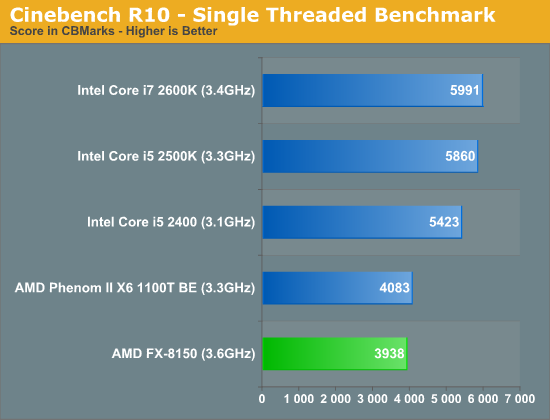
As I alluded to earlier, single threaded performance is going to be a bit of a disappointment with Bulldozer and here you get the first dose of reality. Even considering its clock speed and Turbo Core advantage, the FX-8150 is slower than the Phenom II X6 1100T. Intel's Core i5 2500K delivers nearly 50% better single threaded performance here than the FX-8150.
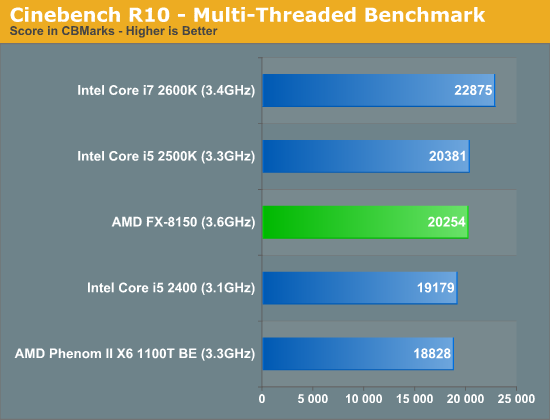
Crank up the threads and the FX-8150 shines, finally tying the 2500K at a comparable price point.
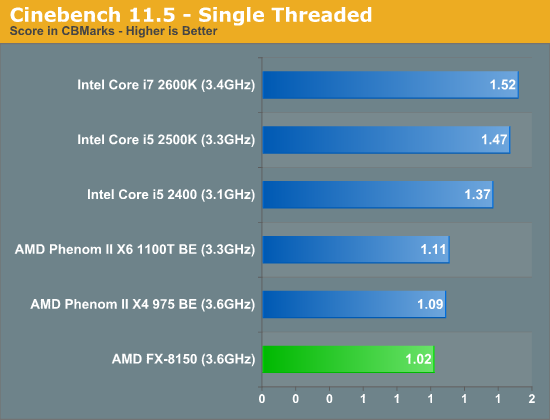
Even with more modern workloads, the FX-8150 isn't able to compete in single threaded speed. Here the 2500K is 44% faster.
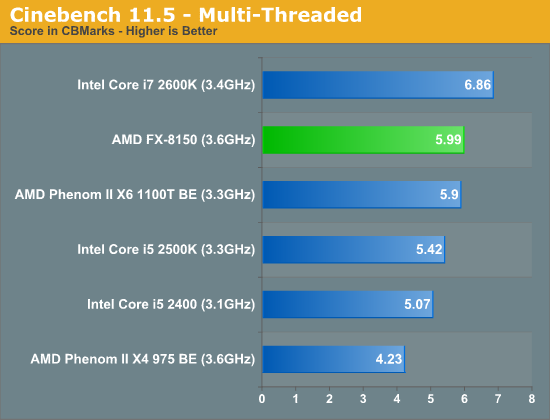
Modern multithreaded workloads however do quite well on Bulldozer. The gains over the old Phenom II X6 1100T are unfortunately not as large as we would expect them to be.
7-Zip Benchmark
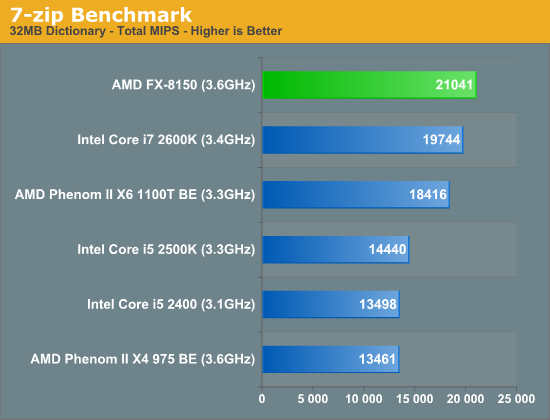
Heavily threaded workloads obviously do well on the FX series parts, here in our 7-zip test the FX-8150 is actually faster than Intel's fastest Sandy Bridge.
PAR2 Benchmark
Par2 is an application used for reconstructing downloaded archives. It can generate parity data from a given archive and later use it to recover the archive
Chuchusoft took the source code of par2cmdline 0.4 and parallelized it using Intel’s Threading Building Blocks 2.1. The result is a version of par2cmdline that can spawn multiple threads to repair par2 archives. For this test we took a 708MB archive, corrupted nearly 60MB of it, and used the multithreaded par2cmdline to recover it. The scores reported are the repair and recover time in seconds.
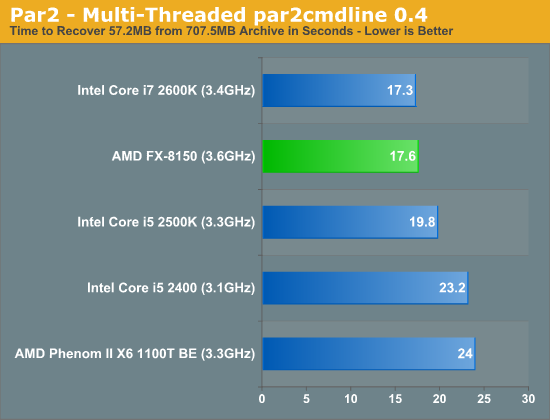
Once again, throw more threads at the processor and the FX-8150 can outperform the Core i5 2500K.
TrueCrypt Benchmark
TrueCrypt is a very popular encryption package that offers full AES-NI support. The application also features a built-in encryption benchmark that we can use to measure CPU performance with:
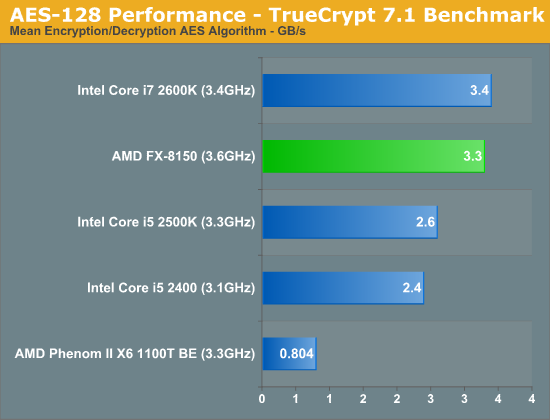
Bulldozer adds AES-NI acceleration, a feature that wasn't present in the Phenom II X6. As a result the FX-8150 is among the fastest at real time AES encryption/decryption, second only to the 2600K. Intel's artificial segmentation using Hyper Threading comes back to haunt it here as the 2500K is significantly slower than the 8-threaded beast.
x264 HD 3.03 Benchmark
Graysky's x264 HD test uses x264 to encode a 4Mbps 720p MPEG-2 source. The focus here is on quality rather than speed, thus the benchmark uses a 2-pass encode and reports the average frame rate in each pass.
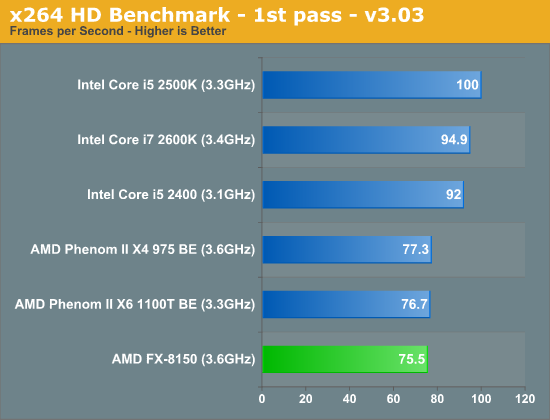
As I mentioned earlier, the first pass of our x264 HD benchmark is a lightly threaded task. As such, the FX-8150 doesn't do very well here. Even the old Phenom II is able to inch ahead of AMD's latest. And Sandy Bridge obviously does very well.

The second pass is more thread heavy, allowing the FX-8150 to flex its muscle and effectively tie the 2600K for first place.
AMD also sent along a couple of x264 binaries that were compiled with AVX and AMD XOP instruction flags. We ran both binaries through our x264 test, let's first look at what enabling AVX does to performance:
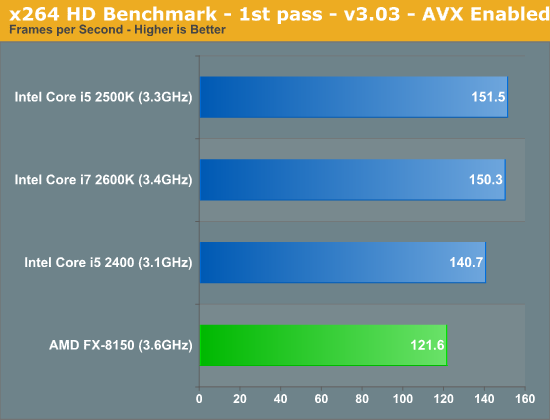
Everyone gets faster here, but Intel continues to hold onto a significant performance lead in lightly threaded workloads.
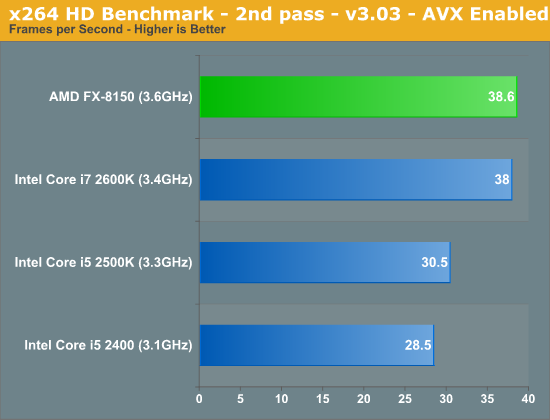
The standings don't change too much in the second pass, the frame rates are simply higher across the board. The FX-8150 is an x86 transcoding beast though, roughly equalling Intel's Core i7 2600K. Although not depicted here, the performance using the AMD XOP codepath was virtually identical to the AVX results.
Adobe Photoshop CS4
To measure performance under Photoshop CS4 we turn to the Retouch Artists’ Speed Test. The test does basic photo editing; there are a couple of color space conversions, many layer creations, color curve adjustment, image and canvas size adjustment, unsharp mask, and finally a gaussian blur performed on the entire image.
The whole process is timed and thanks to the use of Intel's X25-M SSD as our test bed hard drive, performance is far more predictable than back when we used to test on mechanical disks.
Time is reported in seconds and the lower numbers mean better performance. The test is multithreaded and can hit all four cores in a quad-core machine.
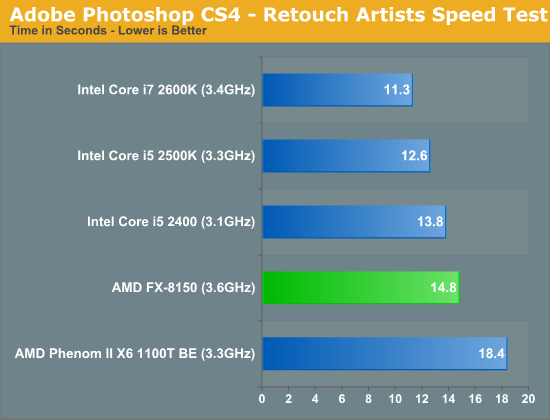
Photoshop performance improves tangibly over the Phenom II X6, unfortunately it's not enough to hang with the enthusiast Sandy Bridge parts.
Compile Chromium Test
You guys asked for it and finally I have something I feel is a good software build test. Using Visual Studio 2008 I'm compiling Chromium. It's a pretty huge project that takes over forty minutes to compile from the command line on a dual-core CPU. But the results are repeatable and the compile process will easily stress more than 8 threads on a CPU so it works for me.
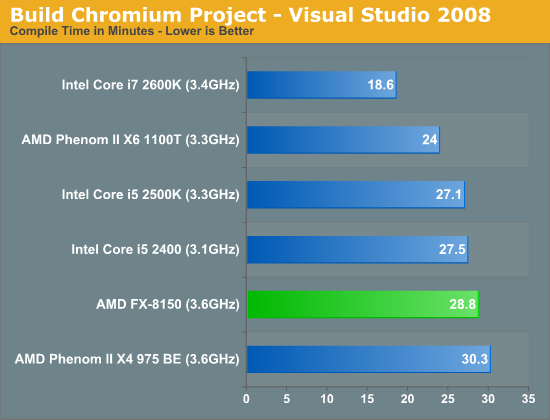
Our compiler test has traditionally favored heavily threaded architectures, but here we found the Phenom II X6 1100T to offer a tangible performance advantage over Bulldozer. While AMD is certainly competitive here, this is an example of one of those situations where AMD's architectural tradeoffs simply don't pay off—not without additional clock speed that is.
Excel Monte Carlo

Our final application test is another win for AMD over the Core i5 2500K. The victory is entirely a result of Intel's Hyper Threading restrictions though, the eight-thread 2600K is able to easily outperform Bulldozer. Either way, AMD delivers better performance here for less money.










430 Comments
View All Comments
nofumble62 - Thursday, October 13, 2011 - link
Crappy building block will mean crappy building.richaron - Friday, October 14, 2011 - link
At first I was pissed off by being strung along for this pile of tripe. After sleeping on it, I am not completely giving up on this SERVER CHIP:1) FX is a performance moniker, scratch stupid amount of cache & crank clock
2) I'm sure these numbties can get single thread up to thuban levels
3) Patch windows scheduler ffs
Fix those (relatively simple) things & it will kick ass. But it means most enthusiasts wont be spending money on AMD for a while yet.
7Enigma - Friday, October 14, 2011 - link
Biggest problem for a server chip is the load power levels. It just doesn't compete on that benchmark and one in which is VERY important for a server environment from a cost/heat standpoint.Let's hope that's just a crappy leaky chip due to manufacturing but it's to early to tell.
richaron - Friday, October 14, 2011 - link
I've worked in a 'server environment'. of course power consumption is an issue. at the lower clock speeds & considering multithread performance, this is already a good/great contender. virtual servers & scientific computing this is already a winnar.with a few (hardware & software) tweaks it could be a GREAT pc chip in the long term.
ryansh - Friday, October 14, 2011 - link
Anyone have a BETA copy of WIN8 to see if BD's performance increases like AMD says it will.silverblue - Friday, October 14, 2011 - link
There's benchmarks here and there but nothing to say it'll improve performance more than 10% across the board. In any case, the competition also benefits from Windows 8, so it's still not a sign of AMD closing any sort of gap in a tangible fashion.Pipperox - Friday, October 14, 2011 - link
But Bulldozer is different.Windows 7 scheduler does not have a clue about its "modules" and "cores".
So for example it may find it perfectly legit to schedule 2 FP intensive threads to the same module.
Instead this will result in reduced performance on Bulldozer.
Also one may want to schedule two integer threads which share the same memory space to the same module, instead of 2 different modules.
This way the two threads can share the same L2 cache, instead of having to go to the L3 which would increase latency.
All of the above does not apply to Thuban; to a lesser degree it applies to Sandy Bridge, but Windows 7 scheduler is already aware of Sandy Bridge's architecture.
nirmv - Saturday, October 15, 2011 - link
Pipperox, It's not different than Intel's Hyper Threading.Pipperox - Sunday, October 16, 2011 - link
It is, although they're similar concepts.Let's make an example: you have 2 integer threads working on the same address space (for example two parallel threads working in the same process).
All cores are idle.
What is the best scheduling for a Hyperthreading cpu?
You schedule each thread to a different core, so that they can enjoy full execution resources.
What is best on Bulldozer?
You schedule them to the SAME module.
This because the execution resources are split in a BD module, so there would be no advantage to schedule the threads to different modules.
HOWEVER if the 2 threads are on the same module, they can share the L2 cache instead of the L3 cache on BD, so they enjoy lower memory latency and higher bandwidth.
There are cases where the above is not true, of course.
But my example shows that optimal scheduling for Hyperthreading can be SUB-optimal on Bulldozer.
Hence the need for a Bulldozer-aware scheduler in Windows 8.
Regs - Friday, October 14, 2011 - link
AMD needs a 40-50% performance gain and they're not going to see it using windows 8. What AMD needs is...actually I have no clue what the need. I've never been so dumbfounded about a product that makes no sense or has any position in the market.